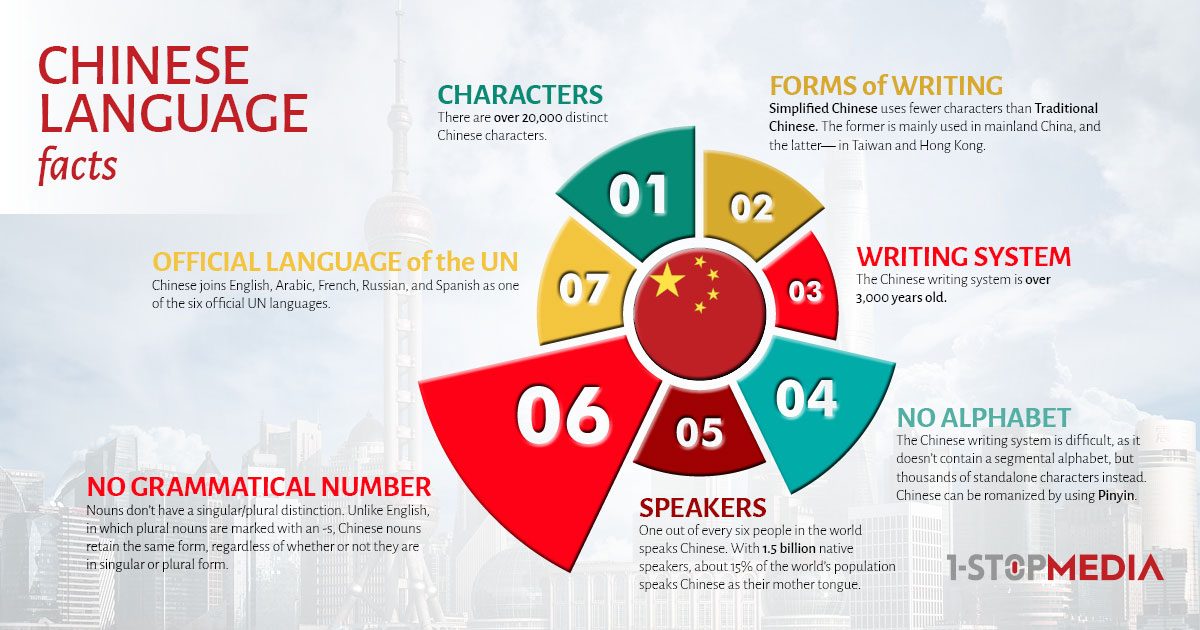Chinese Language
Chinese is by far the most widely spoken language in the world. In addition, it’s the fastest-growing language in the world, in both numbers of speakers and economic value. Over a billion people learn it as their first language. It is no wonder that Chinese translation is one of the most demanded services in the Asian languages segment.
The Chinese Media Scene
Currently, China is producing a huge amount of media content and at the same time is one of the largest target markets if one wants to increase the viewership of a certain media product. That leads to a very large demand for Chinese media services including Chinese subtitling and dubbing translation services, which are part of our 1-StopMedia portfolio.
Facts that affect Chinese to English and to other languages translations:

The complexity of Chinese translation
1. The written language > Translation Service
- Writing system: There are two writing systems; Simplified Chinese — mainly used in mainland China, and Traditional Chinese — mainly used in Taiwan and Hong Kong.
- Characters: The most obvious difference is the characters. Simplified Chinese, as its name indicates, has a simplified version of each character, so they’re easier to write and memorize. Traditional Chinese keep the original forms, which have developed over the course of a thousand years. Therefore, it’s easier for people who understand Traditional Chinese to pick up Simplified Chinese, but the opposite isn’t true.
- Honorifics: Chinese poses a considerable challenge for translation because of its abundant dialects, and the minor differences in the language used throughout the various territories it’s spoken in. As an example, there are two types of “you” — “您” (formal, honorific) and “你” (informal).
- Localization: Traditional Chinese is mainly used in Hong Kong and Taiwan, thus localization (especially the choice of words and expressions) is very important and dependent on your target market. Clients and/or native speakers from these two places will be able to tell the differences. There is another target audience that’s located in North America – the Chinese-speaking community. The older generation mostly immigrated from Hong Kong and Taiwan, while the newer generation immigrated from China. This is the reason why clients usually ask for both Simplified Chinese and Traditional Chinese translations when translating content that is to be used by Chinese speakers in North America.
2. The spoken language > Media Service
- Tone: All varieties of spoken Chinese use tones to distinguish words. A few dialects of North China may have as few as 3 tones, while some dialects in south China have up to 6 or 12 tones, depending on how one counts them. One exception from this is Shanghainese, which has reduced the set of tones to a two-toned pitch-accent system, not unlike modern Japanese. Different tones can drastically change a word’s meaning. Chinese is a tonal language, meaning that a word’s pitch can affect its meaning. For example, wǒ xiǎng wèn nǐ, in which “wen” is spoken with a falling pitch, means “I want to ask you”. But wǒ xiǎng wěn nǐ, in which “wen” rises and falls in pitch, means “I want to kiss you”.
1-StopMedia’s solution for you
At 1-StopMedia we believe that sharing our experience with our clients and partners is an essential part of delivering the services your company needs. We branched out from 1-StopAsia with the single purpose of concentrating on improving our media translation services and creating a flawless and tailored solution for LSPs and large business companies that require media services for Asian languages.
Drawing from over 20 years of experience, we benefit from the skillful and accurate translators we have and at the same time fit our process to match your workflow and requirements. Our project managers are experienced in working with Asian languages, work as per ISO 17100 and ISO 9001 and at the same time can advise you on the type of services your company needs.
Request a Free Quote
We, at 1-StopMedia, are aware that responsiveness and excellent project management are the essence when working within the translation industry.
If you feel it is time to improve your time-management and pay more attention to your clients, get in contact with our Production Team and check how we can help you achieve it.
Ask us anything you need to know about:
- quotes and pricing
- translations and media services
- Asian languages
Start your new project with us today! All you have to do is fill in the form on the right and get your free quote.